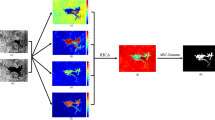Abstract
Automated scene identification is a crucial component of environmental monitoring since it makes it possible to analyse and manage various landscapes effectively. In this study, we examine how different clustering methods perform when used to the Intel Image Classification dataset, which consists of six different classes: roads, buildings, glaciers, sea, mountains, and woods. Our main objective is to find significant patterns in the information that will help with proper scene categorization.
We used PCA (Principal Component Analysis) to improve clustering effectiveness by reducing the dimensionality of the picture information. Then, we used K-Means, Agglomerative, BIRCH, DBScan, and Spectral clustering, five well-known clustering techniques. To evaluate the effectiveness of each method, we employed three assessment metrics: silhouette score, Calinski-Harabasz index, and Davies-Bouldin index.
Despite only creating two clusters, our results showed that Spectral clustering consistently beat the other methods in all three assessment measures. This outcome highlights the effectiveness of spectral clustering in capturing non-linear features inherent in the data, resulting in a better comprehension of the underlying scene categories. K-Means, Agglomerative, and BIRCH also produced four clusters, but DBScan found a cohesive structure with just one cluster, showing the dataset had particular properties.
In order to handle a modest number of clusters, K-Means, Agglomerative, and BIRCH were used. DBScan was used to find density-based clusters and outliers. The potential of spectral clustering to reveal non- linear patterns is why it was chosen.
The development of automatic scene identification for environmental monitoring is aided by our study. We emphasise the significance of taking into account non-linear correlations in picture data. Our findings sets the door for more in-depth investigation of feature extraction methods to improve scene categorization precision, ultimately assisting wise and long-lasting environmental monitoring practises.
In conclusion, this paper proposes a thorough cluster analysis strategy for automated scene identification, demonstrating the potency of Spectral clustering for locating non-linear features in the Intel Image Classification dataset. The research’s findings and new knowledge can help advance automatic scene identification technology, which will help environmental monitoring and associated applications.
Access this chapter
Tax calculation will be finalised at checkout
Purchases are for personal use only
Similar content being viewed by others
References
Kanungo, T., Mount, D.M., Netanyahu, N.S., Piatko, C., Silverman, R., Wu, A.Y.: The analysis of a simple k-means clustering algorithm. In: Proceedings of the Sixteenth Annual Symposium on Computational Geometry, pp. 100–109, May 2000
Deng, D.: DBSCAN clustering algorithm based on density. In: 2020 7th International Forum on Electrical Engineering and Automation (IFEEA), Hefei, China, pp. 949–953 (2020). https://doi.org/10.1109/IFEEA51475.2020.00199
Zhang, T., Ramakrishnan, R., Livny, M.: BIRCH: a new data clustering algorithm and its applications. Data Min. Knowl. Disc. 1, 141–182 (1997)
Sasirekha, K., Baby, P.: Agglomerative hierarchical clustering algorithm-a. Int. J. Sci. Res. Publ. 83(3), 83 (2013)
Naeem, A., Rehman, M., Anjum, M., Asif, M.: Development of an efficient hierarchical clustering analysis using an agglomerative clustering algorithm. Curr. Sci. 117(6), 1045–1053 (2019)
Wilkin, G.A., Huang, X.: K-means clustering algorithms: implementation and comparison. In: Second International Multi-Symposiums on Computer and Computational Sciences (IMSCCS 2007), pp. 133–136. IEEE, August 2007
Sinaga, K.P., Yang, M.S.: Unsupervised K-means clustering algorithm. IEEE Access 8, 80716–80727 (2020)
Ackermann, M.R., Blomer, J., Kuntze, D., Sohler, C.: Analysis of agglomerative clustering. Algorithmica 69, 184–215 (2014)
Day, W.H., Edelsbrunner, H.: Efficient algorithms for agglomerative hierarchical clustering methods. J. Classif. 1(1), 7–24 (1984)
Zhang, T., Ramakrishnan, R., Livny, M.: BIRCH: an efficient data clustering method for very large databases. ACM SIGMOD Rec. 25(2), 103–114 (1996)
Rahmani, M.K.I., Pal, N., Arora, K.: Clustering of image data using K-means and fuzzy K-means. Int. J. Adv. Comput. Sci. Appl. 5(7) (2014)
Gupta, M.K., Chandra, P.: A comparative study of clustering algorithms. In: 2019 6th International Conference on Computing for Sustainable Global Development (INDIACom), New Delhi, India, pp. 801–805 (2019)
Xu, R., WunschII, D.: Survey of clustering algorithms. IEEE Trans. Neural Netw. 16(3), 645–678 (2005). https://doi.org/10.1109/TNN.2005.845141
Murtagh, F.: A survey of recent advances in hierarchical clustering algorithms. Comput. J. 26(4), 354–359 (1983)
Fung, G.: A comprehensive overview of basic clustering algorithms (2001)
Ng, A., Jordan, M., Weiss, Y.: On spectral clustering: analysis and an algorithm. Adv. Neural Inf. Process. Syst. 14 (2001)
Jia, H., Ding, S., Xu, X., Nie, R.: The latest research progress on spectral clustering. Neural Comput. Appl. 24, 1477–1486 (2014)
Zhang, L., Zhang, L., Du, B.: Deep learning for remote sensing data: a technical tutorial on the state of the art. IEEE Geosci. Remote Sens. Mag. 4(2), 22–40 (2016)
Soudy, M., Afify, Y., Badr, N.: RepConv: a novel architecture for image scene classification on Intel scenes dataset. Int. J. Intel. Comput. Inf. Sci. 22(2), 63–73 (2022)
Wu, Y., Wang, Z., Ripplinger, C.M., Sato, D.: Automated object detection in experimental data using combination of unsupervised and supervised methods. Front. Physiol. 13, 469 (2022)
Zhao, L., Li, S.: Object detection algorithm based on improved YOLOv3. Electronics 9(3), 537 (2020)
Patel, K., Rambach, K., Visentin, T., Rusev, D., Pfeiffer, M., Yang, B.: Deep learning-based object classification on automotive radar spectra. In: 2019 IEEE Radar Conference (RadarConf), pp. 1–6. IEEE, April 2019
Author information
Authors and Affiliations
Corresponding authors
Editor information
Editors and Affiliations
Rights and permissions
Copyright information
© 2023 The Author(s), under exclusive license to Springer Nature Switzerland AG
About this paper
Cite this paper
Waykole, Y., Kanathey, Y., Goel, V., Bongale, A., Kadam, P., Kadam, K. (2023). Automated Scene Recognition for Environmental Monitoring: A Cluster Analysis Approach using Intel Image Classification Dataset. In: Tiwari, S., Ortiz-Rodríguez, F., Mishra, S., Vakaj, E., Kotecha, K. (eds) Artificial Intelligence: Towards Sustainable Intelligence. AI4S 2023. Communications in Computer and Information Science, vol 1907. Springer, Cham. https://doi.org/10.1007/978-3-031-47997-7_5
Download citation
DOI: https://doi.org/10.1007/978-3-031-47997-7_5
Published:
Publisher Name: Springer, Cham
Print ISBN: 978-3-031-47996-0
Online ISBN: 978-3-031-47997-7
eBook Packages: Computer ScienceComputer Science (R0)




